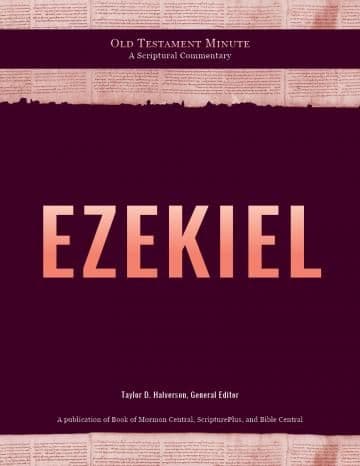Book
2 Chapters

“A wheel in the middle of a wheel.” (Ezekiel 1:16)
What might Ezekiel have seen during the vision that burst upon him “by the river of Chebar”? (Ezekiel 1:1, 3). As any reader will know, the vision was filled with symbolism that during a quick browse seems strange to modern students of the scriptures. But might it be possible to think of details that can be described in modern terms? This possibility brings us to Ezekiel 1:16.
The notion of “a wheel in the middle a wheel” may well point to a gyroscope that stabilized the apparatus of God’s chariot throne. It is this throne that Ezekiel was sketching out in chapter 1. From Ezekiel’s description, we learn that each of the four wheels was linked in some fashion to each of the four great cherubim, the “four living creatures” (1:5, 15). The wheels did not turn when these great creatures, always united in their actions, moved in one direction or the other.[fn]Ezekiel 1:12, 17, 19; 10:9–11.[/fn]
The cherubim must have stood on a platform because their feet never moved. Hence, it appears that the wheels were attached to this horizontal surface. Why do we suspect this? Because in the middle of the cherubim lay an energy source the prophet called “coals of fire” that generated “lightning.”[fn]Ezekiel 1:13; 10:2; also 10:5, 7.[/fn] These coals must have sat in a container that rested on or was attached to something, presumably a platform, because “the man clothed with linen” stepped “between the wheels” to take in his hand the “coals of fire . . . [to] scatter them over the city [of Jerusalem]” (10:2). When “the man clothed with linen . . . went in” between the cherubim and wheels, he “stood beside the wheels” on a surface of some sort, likely a platform to which the wheels were attached (10:6).
We notice two further features. First, when the man dressed in linen received in his hands the hot coals from one of the cherubs, he took them “and went out” from between the four “living creatures” as if he were walking on a surface (10:7). Second, the wheels “turned not when they went” in one direction or another as if they were firmly attached to something (1:17). The integral fixing of the wheels to the bottom of the chariot-throne was such that Ezekiel could write that “the spirit of the living creature[s] was in the wheels” (1:21), for he could hear that the wheels made a noise as they functioned (3:13).
All of these details leave us with the clear impression that the “wheel in the middle of a wheel” was an intrinsic part of God’s chariot throne. In modern terms, we would call the four wheels gyroscopes. After all, from other sources we learn that in the celestial realm there are skilled artisans that produce items to serve important purposes on earth and, apparently, in heaven. One need only think of the Liahona or the Urim and Thummim as an example of this.
Items in the BMC Archive are made publicly available for non-commercial, private use. Inclusion within the BMC Archive does not imply endorsement. Items do not represent the official views of The Church of Jesus Christ of Latter-day Saints or of Book of Mormon Central.